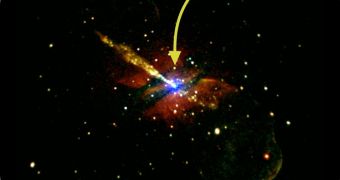A group of astronomers from the University of Birmingham, in the United Kingdom, announces the discovery of an ordinary black hole in a galaxy located very far away from the Milky Way. The low-mass object belongs to a very rare category, of which not many members are known.
This black hole also represents the farthest object of its class ever discovered. It is located about 12 million light-years away from Earth, in the galaxy Centaurus. Its location was recently revealed by an international collaboration of researchers.
In order to study the distant object, the team had to analyze its X-ray emissions, which are produced by the environment around such structures. Most black holes feature an accretion disk around them, which is made up of materials that are about to pass through the event horizon.
Inside these disks, intense friction causes matter to heat up to millions of degrees, thus releasing large amounts of radiation in jet plumes. These can be identified by telescopes such as the NASA Chandra X-ray Observatory (CXO), Space reports.
According to the data the team collected on the Centaurus A black hole thus far, it would appear that the object is currently in the final stages of an outburst, and also that it is part of a binary system. Its companion is a stable star.
“So far we've struggled to find many ordinary black holes in other galaxies, even though we know they are there. To confirm (or refute) our understanding of the evolution of stars we need to search for these objects, despite the difficulty of detecting them at large distances,” says Mark Burke.
He is a graduate student at the University of Birmingham, and a member of the research team. Burke will present the findings this week, at the UK-Germany National Astronomy Meeting, in Manchester.
Harvard-Smithsonian Center for Astrophysics (CfA) astronomer Ralph Kraft led the international collaboration behind the new work, of which Burke was also a part. The group compiled a set of 6 images of Centaurus A, each of which was about 100,000 seconds long.
Studies such as this one have great implications for the way we understand the evolution of the Universe, galaxies, stars, black holes and so on.
“If it turns out that black holes are either much rarer or much more common in other galaxies than in our own it would be a big challenge to some of the basic ideas that underpin astronomy,” Burke concludes.

 14 DAY TRIAL //
14 DAY TRIAL //